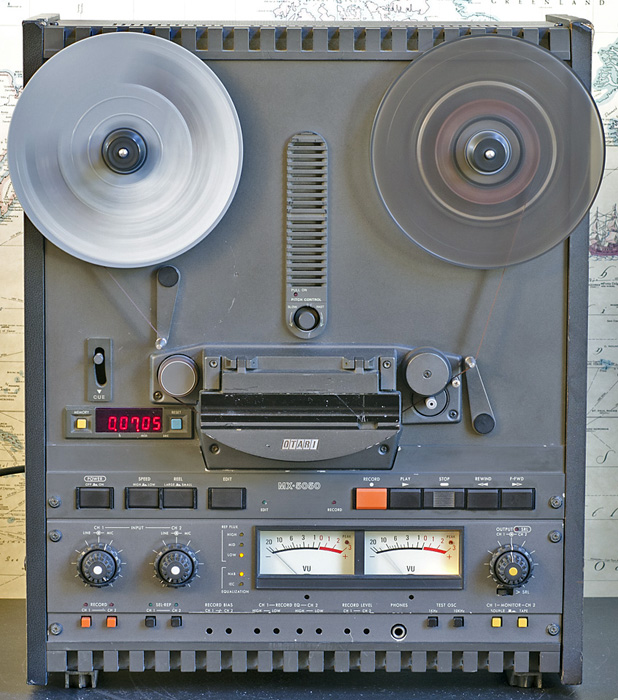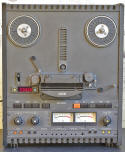-edible zone-
sn18309217
Circa 2008 I purchased this Otari MX 5050 BII 2 from an ebay
seller. This "BII 2" is a 1/4 inch tape 2-track machine that records and
plays back in 2 track mode. Sometimes 2 track machines are called "half
track" Because 1/2 of the tape width is one channel (or track). In
addition to the other three, there is a 4th head. That one is a 4-track
play-back only head. It splits the tape width into 4 tracks (channels).
So this is a very versatile machine. It can record and play back in half
track mode. And it can play back pre-recorded 4-track tapes as well.
In the ad it was listed as being in rough cosmetic condition but
recently serviced and still fully functional. When I took delivery I
found that having the thing in front of me was quite a bit different
than looking at blurry photos in that ebay ad. Nonetheless, it still is
fully functional as described. And it sounds good playing the commercial
R2R recordings I have gathered. Later, I purchased another Otari of the
same model. But that one was in near mint condition. And for not much
more money. But I digress. This page is dedicated to the roughly handled
R2R deck we see in the photos below.
I'll refrain from
speculating on just how this deck came to be in the condition that it
is. Yet, each broken corner, broken foot, each scratch and each gouge
bears witness to some very rough treatment at the hands of somebody.
Perhaps these photos serve as a testament to the rugged build quality of
the machine.
*
*Above: Maybe it isn't quite obvious but the VU meter on the left has a burnt out bulb. The right VU still lights up. Otherwise both meter function normally.
*

 The feet are broken off just fore of the mounting screws. I can
imagine the deck being dropped when this happened. Nevertheless,
these feet are plastic.
The feet are broken off just fore of the mounting screws. I can
imagine the deck being dropped when this happened. Nevertheless,
these feet are plastic.
*
 These Otari reel clamps have seen better days. They still function
but one of them has a sticky operation.
These Otari reel clamps have seen better days. They still function
but one of them has a sticky operation.
*
 I don't know if these close-up photos are close enough to reveal actual
condition of the 4 heads on this machine. But they can't be
completely toast since the deck sounds good.
I don't know if these close-up photos are close enough to reveal actual
condition of the 4 heads on this machine. But they can't be
completely toast since the deck sounds good.
_______________horizontal rule
*This unit was up for auction on ebay March 2014. The winning
bid was for 158.49. Add shipping. ($86.00) Add ebay final value fee (10%
= $15.85). Add pay pal transaction fee ($6.05)
The buyer was
located in Ohio. Item shipped via UPS. When buyer received the item he
opened a dispute saying the unit was not as described. In a further
description he stated that the unit would not run tape nor would it
rewind. My only choice, per ebay policy, was to refund the buyer's
purchase price plus shipping once I had received it back. But the buyer
had to pay shipping back. Not good for him either.
When It
arrived back to me I observed that the buyers' observations were
correct. I also noticed that there was something heavy inside the casing
of the Otari that was loose and crashing about. I also noticed that the
back cover was dented and screws meant to hold the cover in place were
coming out. Further, the 4 plastic feet attached to the back of the unit
were all smashed and falling apart into small fragments. Clearly, this
reel to reel deck had encountered some rough handling during its trip
out to Ohio. Small wonder. It weighs 60 lbs out of the box. Imagine the
UPS folks trying to handle it. Likely the trip back to Seattle wasn't
too good for it either. Ouch.
Now it needs repairs. Below are
some photos of the damage. Notice the top photo and the large and
heavy transformer. It had broken its steel strapping that held it in
place at some point. Then it was free to crash about while the package
was in transit and being handled.
* Loose transformer hung by its cords and swung about in pendulum fashion.
Ouch. The wrecking ball effect.
Loose transformer hung by its cords and swung about in pendulum fashion.
Ouch. The wrecking ball effect.
*(click thumbnail for full image size)
* Transformer refitted to chassis
Transformer refitted to chassis
* Cracked PCB shows gap in circuit. With the transformer strapped
back in place, this is suspected to be the cause of operational
malfunction.
Cracked PCB shows gap in circuit. With the transformer strapped
back in place, this is suspected to be the cause of operational
malfunction.
*A repair is made to the broken circuit.
- First, the cracked board is epoxied in the area of the crack to secure the board from cracking any further.
- Next, a short length of fine gage copper hookup wire is cut to length. Then either end of it is tinned with solder
- Next, either side of the broken circuit is scraped to uncover the copper surfaces. Once clear of outer coating the circuit is coated lightly with resin flux. Then tinned with solder.
- Lastly the short wire section is soldered to both ends of the broken circuit, to form a bridge and complete the broken circuit
- A multimeter is used to test continuity at either end of the damaged circuit. Continuity is good.
- Now it's time to see if this is the fix.
Then:
* Wow. It functions as before. One VU meter needs a light
bulb. I'll get to that next. The good news is that it plays
back as it should. Currently spinning a BS&T album at 7-1/2 ips.
First album: CIFTTM
Wow. It functions as before. One VU meter needs a light
bulb. I'll get to that next. The good news is that it plays
back as it should. Currently spinning a BS&T album at 7-1/2 ips.
First album: CIFTTM
* In spite of some apparent very rough handling by the shipper (UPS), this
unit continues. It has character. I'll keep it around.
If it continues to function, great. If it fails because of the
cracked pcb's, too bad, but I'll keep it for spare parts.
In spite of some apparent very rough handling by the shipper (UPS), this
unit continues. It has character. I'll keep it around.
If it continues to function, great. If it fails because of the
cracked pcb's, too bad, but I'll keep it for spare parts.
_________________________________________________horizontal rule
*Back to:















